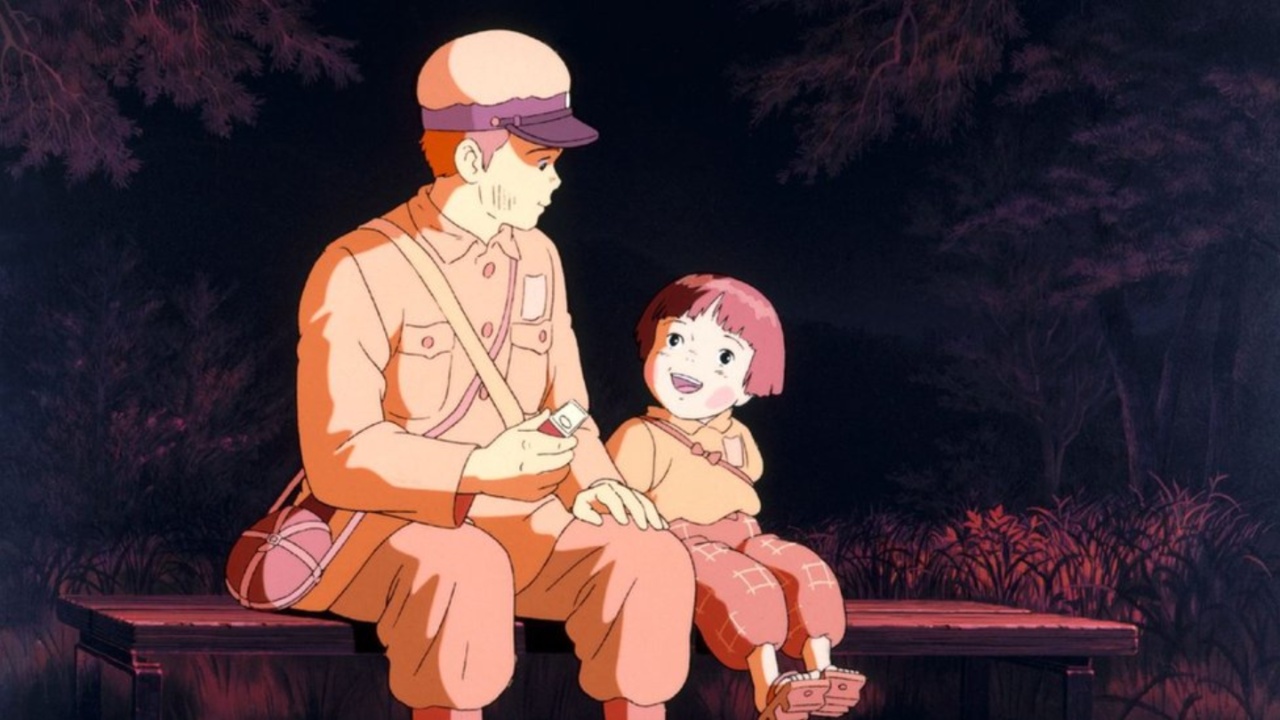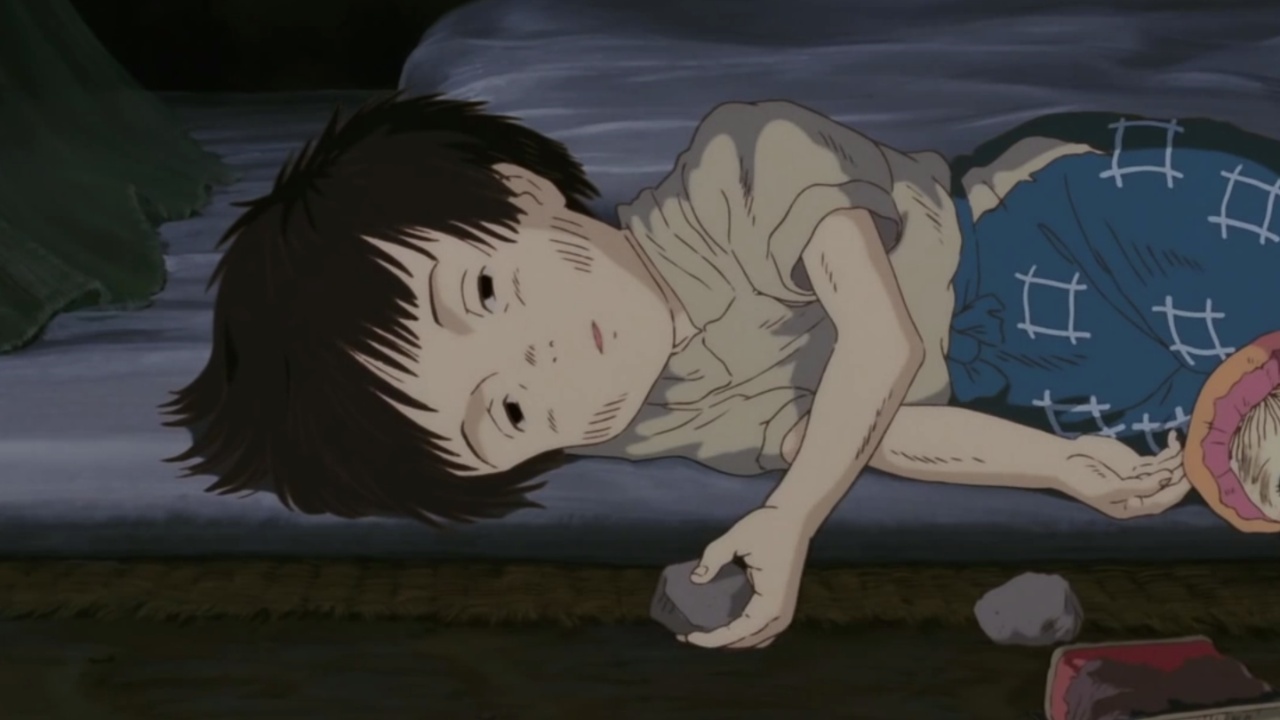Grave of the Fireflies stands as one of the most heartbreaking animated films ever made, remembered for its powerful message about the civilian cost of war. Released in 1988, it was Studio Ghibli’s second major film after Castle in the Sky and was both written and directed by Isao Takahata. The story centers on two siblings, Seita and Setsuko, who attempt to navigate the final months of World War II in Japan after the bombing of their hometown, Kobe.
The film uses their perspective to show how war destroys the lives of everyday people who have no influence over the political decisions that shape their fate. At its core, the movie is a human tragedy that highlights the tenderness of childhood contrasted with the brutality of wartime reality.
After Kobe is consumed by firebombing and the children lose their mother to severe burns, Seita and Setsuko initially seek refuge with an aunt. While she welcomes them at first, her patience fades as food shortages increase and the strain of rationing grows. She becomes resentful of what she perceives as the siblings’ lack of contribution, especially since Seita does not work or assist with the war effort like other young people in the community. Feeling unwelcome and ashamed, the siblings choose to leave the house and settle in an abandoned bomb shelter.
At first, the shelter provides a sense of freedom and a small oasis from the pressures of their aunt’s household. However, as rations tighten throughout Japan, Seita can no longer secure enough food. Despite his desperate efforts, he cannot protect Setsuko from the effects of starvation. Her slow decline culminates in her death from severe malnutrition, followed shortly afterward by Seita’s own death. The film opens with Seita’s death, making the story a reflection seen through the spirits of both children.

Real Experiences And Starvation Illustrate The Film’s Deeply Authentic Wartime Tragedy Story
Although Grave of the Fireflies is a fictional narrative, it draws heavily from the personal experiences of its author, Akiyuki Nosaka, whose short story served as the basis for the film. Nosaka lived through the firebombing of Kobe during World War II and lost two sisters during that period. One died in the bombing, while the younger one, Keiko, died from malnutrition. His sense of guilt over being unable to protect his infant sister led him to write the original story as a form of emotional reconciliation. He viewed the story as an apology and a confession of his perceived failure.
For many years, he resisted attempts to adapt the work into a live-action format because he believed no production could capture its emotional truth. He only approved Studio Ghibli’s adaptation after seeing Takahata’s detailed storyboards. Although fictionalized, the film represents a realistic portrayal of the suffering faced by Japanese civilians during the war, particularly those in heavily bombed cities.
Both children died from starvation and the lack of proper nourishment. Early in the film, Seita is shown dying among several starving boys at a train station, suggesting how widespread death from hunger had become in war-torn Japan. Setsuko’s decline is shown in painful detail. A doctor informs Seita that she is severely malnourished and that she needs food rather than medicine. Her condition worsens until she becomes delirious and begins to eat marbles and rocks, imagining them to be pieces of candy or grains of rice. Seita continues to search for food and even brings her watermelon in a final attempt to revive her strength, but these efforts are too late.

Themes Of Innocence, Loss, Responsibility And War’s Lasting Impact On Human Lives
Although Seita and Setsuko are not far from their aunt’s home, they never return. Seita’s pride plays a major role, but so does his desire to shield Setsuko from harsh realities. He wants to give her comfort and independence, even if he lacks the ability to provide it. He also clings to the belief that their father, who is serving in the Japanese navy, will return to care for them.
When Seita finally learns that Japan has surrendered and that most of the navy has been destroyed, he understands that his father is likely dead. By the time he receives this news, Setsuko has already died. The tragedy arises partly from Seita’s youth and limited understanding of the severity of their situation. He believes he can protect his sister, but he underestimates the danger posed by starvation.
The film emphasizes the suffering endured by ordinary Japanese citizens during World War II. One of the strongest themes is the conflict between innocence and survival. Seita tries to preserve Setsuko’s childhood by shielding her from disturbing truths, including their mother’s death. The tin of Sakuma Drops candy symbolizes this effort. The candy brings Setsuko comfort, but it provides no real nutrition.
When the tin becomes empty, it represents the end of Seita’s ability to sustain her innocence. The fireflies that fill the shelter for one night also symbolize the brief light and joy that the children experience. When the fireflies die and Setsuko buries them, the event becomes a quiet foreshadowing of her own fate. The film uses these gentle symbols to express the fleeting nature of life during wartime.
Grave of the Fireflies has received universal praise from critics and audiences alike, earning a perfect score on Rotten Tomatoes and becoming widely regarded as one of the greatest animated films in history. Critics such as Roger Ebert highlighted the authenticity of its emotional impact and praised its willingness to confront the suffering caused by war.
Glenn Kenny of The New York Times also emphasized the childlike innocence that remains visible in the siblings even as their world collapses around them. Although the film is difficult to watch more than once due to its tragic nature, it is celebrated for its artistic merit and emotional depth. Its portrayal of human resilience, vulnerability, and loss continues to resonate with viewers around the world.



